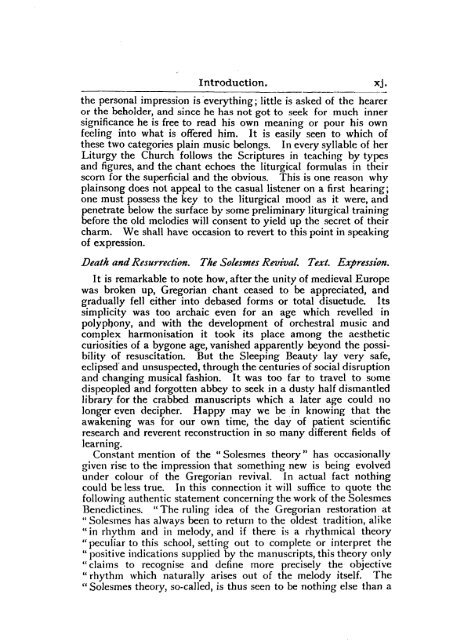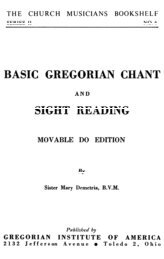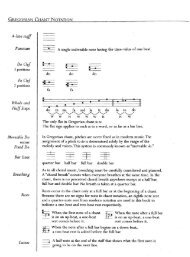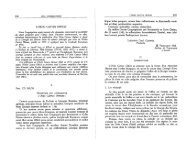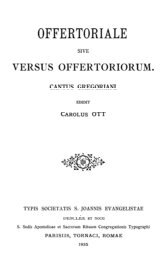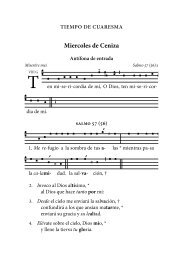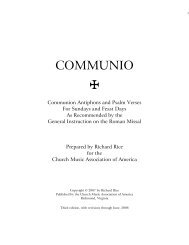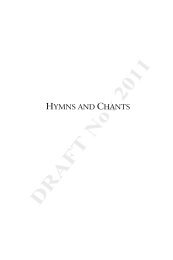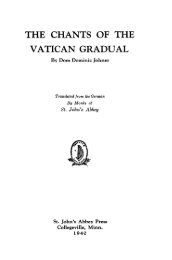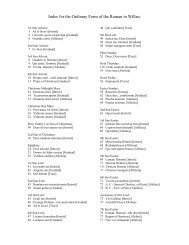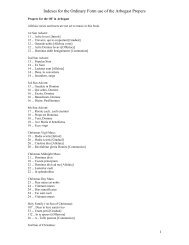Textbook of Gregorian Chant (1930) - MusicaSacra
Textbook of Gregorian Chant (1930) - MusicaSacra
Textbook of Gregorian Chant (1930) - MusicaSacra
Create successful ePaper yourself
Turn your PDF publications into a flip-book with our unique Google optimized e-Paper software.
Introduction. xj.<br />
the personal impression is everything; little is asked <strong>of</strong> the hearer<br />
or the beholder, and since he has not got to seek for much inner<br />
significance he is free to read his own meaning or pour his own<br />
feeling into what is <strong>of</strong>fered him. It is easily seen to which <strong>of</strong><br />
these two categories plain music belongs. In every syllable <strong>of</strong> her<br />
Liturgy the Church follows the Scriptures in teaching by types<br />
and figures, and the chant echoes the liturgical formulas in their<br />
scorn for the superficial and the obvious. This is one reason why<br />
plainsong does not appeal to the casual listener on a first hearing;<br />
one must possess the key to the liturgical mood as it were, and<br />
penetrate below the surface by some preliminary liturgical training<br />
before the old melodies will consent to yield up the secret <strong>of</strong> their<br />
charm. We shall have occasion to revert to this point in speaking<br />
<strong>of</strong> expression.<br />
Death and Resurrection. The Solesmes Revival. Text Expression.<br />
It is remarkable to note how, after the unity <strong>of</strong> medieval Europe<br />
was broken up, <strong>Gregorian</strong> chant ceased to be appreciated, and<br />
gradually fell either into debased forms or total disuetude. Its<br />
simplicity was too archaic even for an age which revelled in<br />
polyphony, and with the development <strong>of</strong> orchestral music and<br />
complex harmonisation it took its place among the aesthetic<br />
curiosities <strong>of</strong> a bygone age, vanished apparently beyond the possibility<br />
<strong>of</strong> resuscitation. But the Sleeping Beauty lay very safe,<br />
eclipsed and unsuspected, through the centuries <strong>of</strong> social disruption<br />
and changing musical fashion. It was too far to travel to some<br />
dispeopled and forgotten abbey to seek in a dusty half dismantled<br />
library for the crabbed manuscripts which a later age could no<br />
longer even decipher. Happy may we be in knowing that the<br />
awakening was for our own time, the day <strong>of</strong> patient scientific<br />
research and reverent reconstruction in so many different fields <strong>of</strong><br />
learning.<br />
Constant mention <strong>of</strong> the "Solesmes theory" has occasionally<br />
given rise to the impression that something new is being evolved<br />
under colour <strong>of</strong> the <strong>Gregorian</strong> revival. In actual fact nothing<br />
could be less true. In this connection it will suffice to quote the<br />
following authentic statement concerning the work <strong>of</strong> the Solesmes<br />
Benedictines. " The ruling idea <strong>of</strong> the <strong>Gregorian</strong> restoration at<br />
" Solesmes has always been to return to the oldest tradition, alike<br />
" in rhythm and in melody, and if there is a rhythmical theory<br />
"peculiar to this school, setting out to complete or interpret the<br />
" positive indications supplied by the manuscripts, this theory only<br />
"claims to recognise and define more precisely the objective<br />
" rhythm which naturally arises out <strong>of</strong> the melody itself. The<br />
" Solesmes theory, so-called, is thus seen to be nothing else than a


